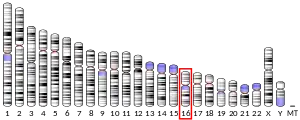SLX4 (also known as BTBD12 and FANCP) is a protein involved in DNA repair, where it has important roles in the final steps of homologous recombination.[5] Mutations in the gene are associated with the disease Fanconi anemia.[6][7]
The version of SLX4 present in humans and other mammals acts as a sort of scaffold upon which other proteins form several different multiprotein complexes. The SLX1-SLX4 complex acts as a Holliday junction resolvase. As such, the complex cleaves the links between two homologous chromosomes that form during homologous recombination. This allows the two linked chromosomes to resolve into two unconnected double-strand DNA molecules.[8] The SLX4 interacting protein interacts with SLX4 in the DNA repair process, specifically in interstrand crosslink repair.[9] SLX4 also associates with RAD1, RAD10 and SAW1 in the single-strand annealing pathway of homologous recombination.[10] The DNA repair function of SLX4 is involved in sensitivity to proton beam radiation.[11]
References
- 1 2 3 GRCh38: Ensembl release 89: ENSG00000188827 - Ensembl, May 2017
- 1 2 3 GRCm38: Ensembl release 89: ENSMUSG00000039738 - Ensembl, May 2017
- ↑ "Human PubMed Reference:". National Center for Biotechnology Information, U.S. National Library of Medicine.
- ↑ "Mouse PubMed Reference:". National Center for Biotechnology Information, U.S. National Library of Medicine.
- ↑ Klein, HL; Symington, LS (10 July 2009). "Breaking up just got easier to do". Cell. 138 (1): 20–22. doi:10.1016/j.cell.2009.06.039. PMID 19596231. S2CID 15429205.
- ↑ Kim Y; Lach FP; Desetty R; Hanenberg H; Auerbach AD; Smogorzewska A (February 2011). "Mutations of the SLX4 gene in Fanconi anemia". Nat. Genet. 43 (2): 142–6. doi:10.1038/ng.750. PMC 3345287. PMID 21240275.
- ↑ van der Weyden L; White JK; Adams DJ; Logan DW (2011). "The mouse genetics toolkit: revealing function and mechanism". Genome Biol. 12 (6): 224. doi:10.1186/gb-2011-12-6-224. PMC 3218837. PMID 21722353.
- ↑ Svendsen, JM; et al. (10 July 2009). "Mammalian BTBD12/SLX4 assembles a Holliday junction resolvase and is required for DNA repair". Cell. 138 (1): 63–77. doi:10.1016/j.cell.2009.06.030. PMC 2720686. PMID 19596235.
- ↑ Zhang, Huimin; Chen, Zhen; Ye, Yin; Ye, Zu; Cao, Dan; Xiong, Yun; Srivastava, Mrinal; Feng, Xu; Tang, Mengfan; Wang, Chao; Tainer, John A. (2019-11-04). "SLX4IP acts with SLX4 and XPF-ERCC1 to promote interstrand crosslink repair". Nucleic Acids Research. 47 (19): 10181–10201. doi:10.1093/nar/gkz769. ISSN 1362-4962. PMC 6821277. PMID 31495888.
- ↑ Mimitou, EP; Symington, LS (2 September 2009). "DNA end resection: Many nucleases make light work". DNA Repair. 8 (9): 983–995. doi:10.1016/j.dnarep.2009.04.017. PMC 2760233. PMID 19473888.
- ↑ Liu, Q; Underwood, TA (1 May 2016). "Disruption of SLX4-MUS81 Function Increases the Relative Biological Effectiveness of Proton Radiation". Int J Radiation Oncol Biol Phys. 95 (1): 78–85. doi:10.1016/j.ijrobp.2016.01.046. PMC 4889010. PMID 27084631.



